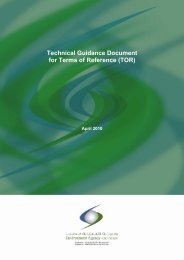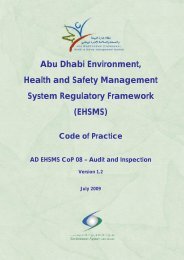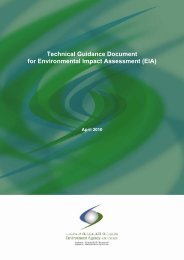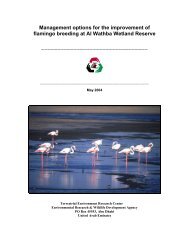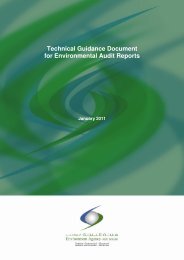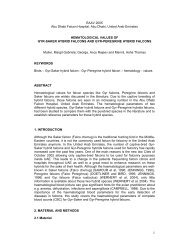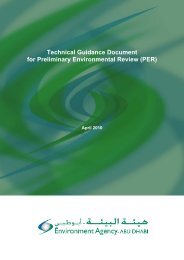Terrestrial - Environment Agency - Abu Dhabi
Terrestrial - Environment Agency - Abu Dhabi
Terrestrial - Environment Agency - Abu Dhabi
Create successful ePaper yourself
Turn your PDF publications into a flip-book with our unique Google optimized e-Paper software.
Acknowledgement<br />
This important publication presents a comprehensive<br />
introduction to the <strong>Terrestrial</strong> <strong>Environment</strong> of <strong>Abu</strong><br />
<strong>Dhabi</strong> Emirate. The publishing of this book would not<br />
have been possible without the contributions made by:<br />
Authors<br />
Abdulrahman Alsharhan Ph.D., Shabbir A. Shahid, Ph. D., Mahmoud<br />
A. Abdelfattah, Ph. D., Nigel Bottomlay, Sheikha Moza Ali Hamed,<br />
Gary Brown, Ph.D., Sàlim Javed, Ph.D., Drew Gardner, Ph.D., FLS.,<br />
Peter Low Cunningham, Dr. Brigitte Howarth, Dr. Michael Paul<br />
Trafford Gillett,<br />
<strong>Terrestrial</strong><br />
<strong>Environment</strong><br />
of <strong>Abu</strong> <strong>Dhabi</strong> Emirate<br />
Photography by<br />
Abdulla Fadel, Abdulnaser Al Shamsi, Andrew Gardner, Bob<br />
Reimer, Brigitte Howarth, Farncy Kakkassery, Gary Brown, Hanne<br />
& Jens Eriksen, Harrison Institute, UK, Iris Gode, Ladislav Molnar,<br />
Majid Al Mansouri, Marijcke Jongbloed, Mohamed Dawoud, Olivier<br />
Conmbreau, Roger Eritiga, Salim Javed, Sigfrid Ingrisch, Xavier<br />
Eichaker.<br />
Editor<br />
Dr. Richard J. Perry<br />
Copyright © 2008 <strong>Environment</strong>al <strong>Agency</strong> -<strong>Abu</strong> <strong>Dhabi</strong>.<br />
All Rights Reserved. No part of this publication may be<br />
reproduced, stored in a retrieval system or transmitted in<br />
any form or by any means, electronic, electrostatic, magnetic<br />
tape, mechanical, photocopying, recording, scanning or<br />
otherwise, without permission in writing from the publisher.<br />
ISBN # ISBN978-9948-408-33-8<br />
Designed and prepared by<br />
<strong>Environment</strong> <strong>Agency</strong>-<strong>Abu</strong> <strong>Dhabi</strong>,<br />
P.O. Box 45553, <strong>Abu</strong> <strong>Dhabi</strong>, UAE<br />
Tel: +971-2-4454777; Fax: +971-2-4463339<br />
Website: www.ead.ae<br />
Produced from camera-ready-copy supplied by the publisher<br />
P.O Box: 45553, <strong>Abu</strong> <strong>Dhabi</strong>, United Arab Emirates,<br />
Tel:+971-2- 4454777; Fax:+971-2- 4463339<br />
Website: www.ead.ae
TABLE OF CONTENTS<br />
Foreword 9<br />
Introduction 11<br />
Acknowledgements 14<br />
Chapter 1<br />
Geology of the <strong>Abu</strong> <strong>Dhabi</strong> Emirate 19<br />
Introduction 20<br />
Climatology 22<br />
Oceannography 22<br />
Structure and tectonic settings 25<br />
Offshore quaternary sedimentation 27<br />
Sedimentution along the coastline complex<br />
and around islands 31<br />
Geomorphology 38<br />
Surface stratigraphy and pateogeography 54<br />
References 65<br />
Chapter 2<br />
Soils of <strong>Abu</strong> <strong>Dhabi</strong> Emirate 71<br />
Introduction 72<br />
Temperature and moisture regimes of the<br />
Emirate soils 72<br />
Entisols – sandy desert soils 73<br />
Aridisols 77<br />
Inceptisols 82<br />
Summary 86<br />
References 86<br />
Chapter 3<br />
Recent Climate of <strong>Abu</strong> <strong>Dhabi</strong> Emirate 93<br />
Introduction 94<br />
The originsof climatic recording in<br />
<strong>Abu</strong> <strong>Dhabi</strong> 94<br />
Data usage 95<br />
Climatic classification of <strong>Abu</strong> <strong>Dhabi</strong> 97<br />
Climatic seasons 98<br />
Climatic conditions 100<br />
References 111<br />
Chapter 4<br />
Water Resources in the Emirate<br />
of <strong>Abu</strong> <strong>Dhabi</strong> 113<br />
Introduction 114<br />
Climate conditions 114<br />
Water resources 115<br />
Springs and falages 123<br />
Jebel Hafit eocene limstone aquifer 134<br />
Al Ain quaternary alluium aquifer 138<br />
Liwa quaternary sand aquifer 142<br />
Physical and chemical properties of the<br />
water aquifer 144<br />
Ground water – flow models 158<br />
Major water resources issues and challenges 160<br />
References 162<br />
Chapter 5<br />
Flora and vegetation of<br />
<strong>Abu</strong> <strong>Dhabi</strong> Emirate 165<br />
Introduction 166<br />
Flora 167<br />
Adaptions of desert plants to their<br />
environment 173<br />
Dominant vegetation types 181<br />
Threats to the natural vegetation and flora 207<br />
References 214<br />
Chapter 6<br />
Birds of the UAE with special<br />
reference to <strong>Abu</strong> <strong>Dhabi</strong> Emirate 219<br />
Introduction 220<br />
Birds studies in the UAE:<br />
A historical perspective 223<br />
Birds habitats in the UAE 225<br />
Status of birds in the UAE 234<br />
Patterns of bird distribution 235<br />
Important and threatened birds in the UAE 241<br />
Threats to birds 247<br />
Important areas for bird conservation 254<br />
Conservation measures 256<br />
Protected areas 256<br />
Priorities for bird conservation 258<br />
Summary 262<br />
References 262<br />
Appendix 1 265<br />
Appendix 2 276<br />
Chapter 7<br />
The Terresterial reptiles of the UAE:<br />
Herpetological history, Zoogeography and<br />
conservation 281<br />
Introduction 282<br />
Herpetological history of the UAE 282<br />
Zoogeography 295<br />
Conservation 295<br />
Summary 301<br />
References 305<br />
Chapter 8<br />
Terresterial mammals of the UAE with special<br />
reference to <strong>Abu</strong> <strong>Dhabi</strong> Emirate 309<br />
Introduction 310<br />
Order Rodenta 312<br />
Order Chiroptera 328<br />
Order Insectivora 338<br />
Order Hyracoidea 343<br />
Order Lagomorpha 345<br />
Order Artiodactyla 346<br />
Order Carnivora 356<br />
References 374<br />
Chapter 9<br />
The terresterial and freshwater<br />
arthropods of <strong>Abu</strong> <strong>Dhabi</strong> Emirate 379<br />
Introduction 380<br />
Systematic account of the arthropods<br />
of <strong>Abu</strong> <strong>Dhabi</strong> 384<br />
Importance of the arthropod fauna<br />
of <strong>Abu</strong> <strong>Dhabi</strong> 428<br />
Summary 431<br />
References 432<br />
Tables 440
FOREWORD<br />
INTRODUCTION<br />
A bleak, barren, inhospitable wilderness is an image<br />
that springs to mind for many people when they think<br />
of the desert. Yet to the initiated, the desert can be a<br />
place of immense beauty, teeming with life and full of<br />
interest. Here in the Emirate of <strong>Abu</strong> <strong>Dhabi</strong> we are<br />
blessed to be surrounded with such beauty, doubly so<br />
when we consider the additional diversity from our<br />
coastal areas and the beautiful azure sea that<br />
abounds with life.<br />
It is our sincerest wish that this book will inspire<br />
readers to explore further and appreciate deeper, the<br />
wonderful natural world that surrounds us here in<br />
<strong>Abu</strong> <strong>Dhabi</strong>. For we hope, that through a greater<br />
appreciation of the beauty of nature around us and an<br />
understanding of its fragility, people will be<br />
encouraged to preserve the natural environment for<br />
themselves and their children's children.<br />
The emirate has seen an incredible pace of<br />
development over the last few years that only seem to<br />
be accelerating and if we are not careful, there is a<br />
danger we will lose much of our natural heritage to<br />
either the bulldozer or the dredger. Fortunately,<br />
steps are being taken to address this that include; the<br />
establishment of the <strong>Environment</strong> <strong>Agency</strong> <strong>Abu</strong> <strong>Dhabi</strong><br />
(formerly the <strong>Environment</strong>al Research and Wildlife<br />
Development <strong>Agency</strong>, ERWDA) and new Laws and<br />
Regulations to protect the environment, the<br />
development of strategic plans, state of the<br />
environment reporting and a whole raft of individual<br />
projects aimed at preserving particular species such<br />
as the Arabian Oryx or the Asian Houbara.<br />
This institutional capacity building coupled with<br />
special projects and awareness raising will help to<br />
enable the fast pace of development to continue with<br />
minimal impact on the beautiful environment that<br />
surrounds us. Indeed, we are already seeing new<br />
prestigious eco-tourism projects seeking to capitalise<br />
on the beautiful natural environment and wildlife of<br />
the emirate.<br />
We trust that you will enjoy this book but also that<br />
you will help to encourage others to preserve the<br />
wonderful natural environment that we have here in<br />
the emirate of <strong>Abu</strong> <strong>Dhabi</strong>.<br />
Hamdan Bin Zayed Al Nahyan<br />
Deputy Prime Minister of UAE,<br />
Chairman of <strong>Environment</strong> <strong>Agency</strong>- <strong>Abu</strong> <strong>Dhabi</strong> Board<br />
9
INTRODUCTION<br />
Background<br />
This book has been a long time in the making for its<br />
predecessor, “Desert Ecology of <strong>Abu</strong> <strong>Dhabi</strong>” (1996 ed.<br />
Patrick Osborne), set a standard that was hard to<br />
beat. So, over a decade on, you might ask why the<br />
need for another book? Well, in the intervening period<br />
much has been achieved. The National Avian<br />
Research Center (NARC) where much of the original<br />
research and survey work was conducted evolved into<br />
the <strong>Environment</strong>al Research and Wildlife<br />
Development <strong>Agency</strong> (ERWDA), which more recently<br />
became the <strong>Environment</strong>al <strong>Agency</strong> – <strong>Abu</strong> <strong>Dhabi</strong><br />
(EAD). During the last decade the Emirate has<br />
developed at an incredible pace, with so much<br />
achieved in terms of economic development and<br />
progress that it is useful to stop and take stock and<br />
reflect upon the natural environment and all its<br />
wonderful glory and to record the advances made in<br />
our knowledge of this environment.<br />
Scope of the book<br />
This book attempts to describe, in a fair amount of<br />
detail, the terrestrial environment of the Emirate of<br />
<strong>Abu</strong> <strong>Dhabi</strong>. Commencing with the bedrock of geology<br />
and moving on through to the life giving soils, the all<br />
determining climate, the ever so precious water<br />
resources, and on to the flora and fauna of this gem of<br />
an Emirate. Even the Emirate’s name “<strong>Abu</strong> <strong>Dhabi</strong>”<br />
(“Father of Gazelle”) reflects the importance that the<br />
emirate places upon the environment and the rich<br />
heritage it has to offer.<br />
The book is not intended to be the definitive source of<br />
all information on the terrestrial environment of <strong>Abu</strong><br />
<strong>Dhabi</strong> Emirate, but it does go a long way towards<br />
providing a detailed picture. Throughout the book<br />
the contributing authors have referenced the<br />
voluminous works of others, such that the reader is<br />
directed towards what must amount to almost the<br />
totality of current knowledge of the terrestrial<br />
environment of the Emirate of <strong>Abu</strong> <strong>Dhabi</strong>. What is<br />
perhaps missing at this stage is detailed spatial<br />
information as to where many of these species and<br />
areas of interest may be found. Much of that<br />
information has yet to be collected or collated.<br />
However, with the recent development of the <strong>Abu</strong><br />
<strong>Dhabi</strong> Global <strong>Environment</strong>al Data Initiative<br />
(AGEDI), it is anticipated that much of the effort will<br />
now turn towards the collection of spatial information<br />
regarding the distribution of species across the<br />
Emirate. Not just for the fauna and flora, there is also<br />
a major initiative underway between EAD and the<br />
International Centre for Biosaline Agriculture (ICBA)<br />
to map the soils of the Emirate.<br />
A quick sketch of the Emirate<br />
<strong>Abu</strong> <strong>Dhabi</strong> is the largest emirate within the United<br />
Arab Emirates (UAE), a federation of seven<br />
sheikhdoms that also includes Dubai, Sharjah,<br />
Fujairah, Ras Al Khaimah, Ajman, and Umm Al<br />
Quwain. Total area of UAE is 77,700 km2, of which<br />
<strong>Abu</strong> <strong>Dhabi</strong> forms 80%.<br />
11
The country lies between 22 o 30’ and 26 o north, and<br />
51 o 30; to 56 o east, on the southern coast of the<br />
Arabian Gulf; nestled between the Straits of Hormuz<br />
in the east and the Qatar Peninsula in the west. <strong>Abu</strong><br />
<strong>Dhabi</strong> forms the north-eastern edge of the Rub’al-<br />
Khali or “Empty Quarter”, and is bordered in the<br />
south and west by Saudi Arabia, and in the east by<br />
Oman (see map).<br />
Desert sands and coastal sediments characterize the<br />
surface geology of the western and central part of the<br />
country, while to the northeast a mountain range<br />
extends from Ras Al Khaimah to Al Fujairah and<br />
extend southward to Al-Ain region (the eastern<br />
provinces of <strong>Abu</strong> <strong>Dhabi</strong> Emirate). The climate of <strong>Abu</strong><br />
<strong>Dhabi</strong> may be classified as ‘desert’, but the emirate<br />
experiences a wide variation of weather throughout<br />
the year. Air temperatures range from 16 – 44 o C and<br />
average annual rainfall is 37mm. Few can forget the<br />
feeling of being sand blasted by the strong ‘shamal’<br />
winds, or the feeling of being lost in a bleak barren sun<br />
baked landscape. However, neither can they forget<br />
the marvel of waking at dawn and finding that the<br />
‘barren’ landscape has been literally teeming with life<br />
all around, as witnessed by the plethora of footprints<br />
left behind in the dew damp sand. There is no<br />
denying that the desert can be bleak and hostile but it<br />
can also be extremely beautiful, peaceful and full of<br />
fascination.<br />
Organisation of the book<br />
The text is divided into nine technical chapters that<br />
provide a comprehensive picture of the terrestrial<br />
environment of <strong>Abu</strong> <strong>Dhabi</strong>. Following this<br />
introduction, the book commences with a detailed<br />
look at the geology, by Abdulrahman Al Sharhan, and<br />
the soils, by Shabbir Shahid, that so heavily influence<br />
the character of the natural environment. Chapter 4<br />
revisits the chapter by Nigel Bottomley on climate in<br />
the original “Desert Ecology of <strong>Abu</strong> <strong>Dhabi</strong>’ and<br />
updated by Shaikha Moza Ali Hamed Al Mualla.<br />
Chapter 5, by Abdulrahman Al Sharhan, examines the<br />
precious water resources of the Emirate. The<br />
remaining chapters describe the flora and fauna of the<br />
Emirate with chapters by Dr. Gary Brown, Dr. Sàlim<br />
Javed, Professor Drew Gardner, Dr. Peter<br />
Cunningham, and Dr. Brigitte Howarth & Dr. Michael<br />
Paul Trafford Gillett on vegetation, birds, reptiles,<br />
mammals, and arthropods respectively.<br />
Epilogue<br />
In terms of an understanding of the beauty, diversity<br />
and even fragility of the terrestrial environment of the<br />
Emirate of <strong>Abu</strong> <strong>Dhabi</strong> it is my heartfelt desire that<br />
this book provides the reader with a deeper<br />
understanding and even a sense of belonging. For it<br />
once we feel that we belong that we truly begin to<br />
respect and have a desire to protect. Protect we must,<br />
if we are to pass on to our children and our children’s<br />
children an environment that is as beautiful and<br />
intact as the one we inherited.<br />
So, before you commence your journey through this<br />
book, I shall leave you with a poem that portrays the<br />
beauty of the desert we inhabit and that sense of<br />
belonging and peace one feels when you take the time<br />
to stop and look at the beauty all around.<br />
I trust that you find this book educational as well as<br />
enlightening and I pray that it inspires you, and those<br />
you come into contact with, to protect and preserve<br />
the beautiful and delicate terrestrial environment of<br />
the Emirate of <strong>Abu</strong> <strong>Dhabi</strong>.<br />
Mohammed Al Bowardi<br />
Secretary General, Executive Council - <strong>Abu</strong> <strong>Dhabi</strong>,<br />
Managing Director, <strong>Environment</strong> <strong>Agency</strong> - <strong>Abu</strong> <strong>Dhabi</strong><br />
Rub’al-Khali<br />
Listen to the stillness,<br />
to the total quiet.<br />
Listen to the calmness,<br />
the beating of your heart.<br />
Feel the baking dryness,<br />
Blasting upon your face.<br />
Feel the rivulets of sweat,<br />
Cascading down your brow.<br />
As you take the first steps<br />
Across sun baked sabkha,<br />
towards the blowing sands,<br />
hear the crisp, sharp footsteps<br />
as you crunch cross the land,<br />
turn and stop a moment.<br />
Watch footprints disappear<br />
washed by rolling sands.<br />
Watch the dhub lizard bask<br />
and the sand fish burrow<br />
in the cool leeward sand.<br />
Take all this in as you<br />
inhale the desert air,<br />
as it burns throat and lungs,<br />
remember where you are.<br />
Marvel at the beauty,<br />
the Place called “Rub’al-Khali”,<br />
the “empty quarter”, where<br />
peace is all around, and<br />
where tranquility hangs<br />
the vastness of the sands.<br />
Richard Perry<br />
12
ACKNOWLEDGEMENTS<br />
Chapter 1<br />
Prof. A.S. Alsharhan would like to thank Professor<br />
Christopher Kendall (University of South Carolina,<br />
USA), who edited and made valuable suggestions that<br />
improved this chapter.<br />
Chapter 2<br />
The authors, Dr. Shabbir A. Shahid and Dr. Mahmoud<br />
A. Abdelfattah, would like to express their<br />
appreciation and gratitude to Mr. Majid Al Mansouri,<br />
Secretary General of <strong>Environment</strong> <strong>Agency</strong> –<strong>Abu</strong><br />
<strong>Dhabi</strong> (EAD) for his vision, support and<br />
encouragement to complete the state-of-the-art Soil<br />
Survey for the Coastline of <strong>Abu</strong> <strong>Dhabi</strong> Emirate that<br />
enabled, to a great extent, the authors to complete<br />
this chapter. The authors would also like to thank Dr.<br />
Mohammed Al-Attar (ICBA Director General) and<br />
Dr. Faisal Taha (Director Technical Programs) for<br />
their understanding with EAD management and to<br />
accept the invitation to complete this important task.<br />
The assistance provided by the project staff in<br />
executing coastline survey is greatly acknowledged.<br />
Chapter 5<br />
Dr. Gary Brown is grateful to Dr P.J. Cowan (Stirling,<br />
UK) for helpful comments on a draft version of the<br />
manuscript, also to Fiona Sewell (Cheltenham, UK)<br />
and Sabitha Sakkir (<strong>Abu</strong> <strong>Dhabi</strong>). He would also like<br />
to thank EAD management, in particular Mr. Majid<br />
Mansouri (<strong>Abu</strong> <strong>Dhabi</strong>), for the invitation to write the<br />
chapter.<br />
Chapter 6<br />
Dr. Sàlim Javed wishes to acknowledge the support<br />
provided by EAD. He sincerely thanks Mr. M. A.<br />
Mansouri, Secretary General of EAD for his support<br />
and invitation to write the chapter on birds of the<br />
UAE. He thanks Dr. F. J. Launay, Assistant Secretary<br />
General for Science and Research of EAD for his help<br />
and comments on a previous draft of this chapter. He<br />
thanks Mr. J. Newby, Director TERC and Dr. A.<br />
Bashir and Mr. T. Abdessalam for their support and<br />
encouragement. Also expresses thanks to his<br />
colleagues Dr. C. Tourenq for his comments on a<br />
previous draft of the manuscript and A. Thanappan<br />
and S. Khan for their help. Lastly he wishes to<br />
acknowledge the help of his wife T. Shafiq.<br />
Chapter 7<br />
Professor Drew Gardner is deeply grateful to the<br />
many dedicated naturalists who allowed him access<br />
to their observations and data on reptiles in the UAE,<br />
without which this work would have been much the<br />
poorer. Particular thanks are due to Gary Feulner,<br />
who carefully went through his field notes over the<br />
last 16 years and extracted all the reptile and<br />
amphibian records, and to Sherif Baha el Din who<br />
provided his invaluable <strong>Abu</strong> <strong>Dhabi</strong> data. Marijcke<br />
Jongbloed, Simon Aspinall, Chris Drew, Peter<br />
Cunningham, Ron Loughland, Pritpal Singh and Rob<br />
Felix all who kindly provided their information and<br />
distribution records.<br />
Chapter 8<br />
Dr. Peter Cunningham expresses his sincere gratitude<br />
to his wife, Janke, and also Gary Feulner who<br />
commented extensively on an earlier draft of this<br />
chapter and whose constructive comments regarding<br />
various publications have been well received over the<br />
years.<br />
Chapter 9<br />
The authors, Dr. Brigitte Howarth and Dr. Michael<br />
Paul Trafford Gillett, wish to thank many people who<br />
have been helpful in so many ways: Mr Robert Reimer<br />
for his continuous enthusiasm, support, friendship<br />
and help with caption writing not to forget his<br />
wonderful illustrations; Mrs Barbara Reimer for<br />
encouragement, support and friendship; Dr Andrew<br />
Gardner for encouragement and the use of his<br />
photograph for figure 10.6; Mr Omar Nasser for his<br />
enthusiasm and company on many collecting trips; Dr<br />
Anithakumari Saji at <strong>Environment</strong>al <strong>Agency</strong> – <strong>Abu</strong><br />
<strong>Dhabi</strong> for her cooperation and sharing of records; the<br />
librarians at <strong>Environment</strong>al <strong>Agency</strong> – <strong>Abu</strong> <strong>Dhabi</strong> for<br />
unlimited access to the resources and photocopier; Dr<br />
Ahmed Khider and Mrs Manisha Pilai at<br />
<strong>Environment</strong>al <strong>Agency</strong> – <strong>Abu</strong> <strong>Dhabi</strong> for their patience<br />
and encouragement; members of the Al Ain Chapter<br />
of the Emirates Natural History Group (ENHG) for<br />
enthusiasm and their company on many trips<br />
including help with collecting arthropods; Mr Conrad<br />
Gillett and Mr James Gillett for help with collecting<br />
and identifications; Mr Brien Holmes (Al Ain ENHG<br />
Chairman) for valuable comments on the draft and<br />
continuous encouragement; Entomology staff at the<br />
Natural History Museum, London, for help with<br />
identifications; Dr Antonius Van Harten for thoughts<br />
and discussions on the content. Both authors would<br />
like to thank their respective families for their<br />
patience and support, and specifically would like to<br />
thank Dr Frank Christopher Howarth for his patience<br />
and understanding whilst the authors took over the<br />
Howarth home during some of the writing. BH<br />
dedicates this chapter to her son, Luke Alexander<br />
Howarth, who helped with collecting and preparation<br />
of specimens and also the selection of photographs to<br />
illustrate the text.<br />
14 15





